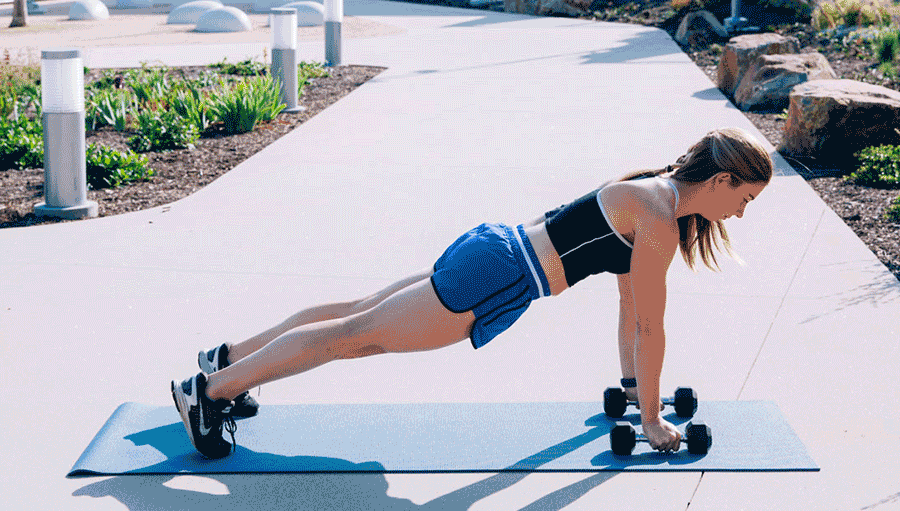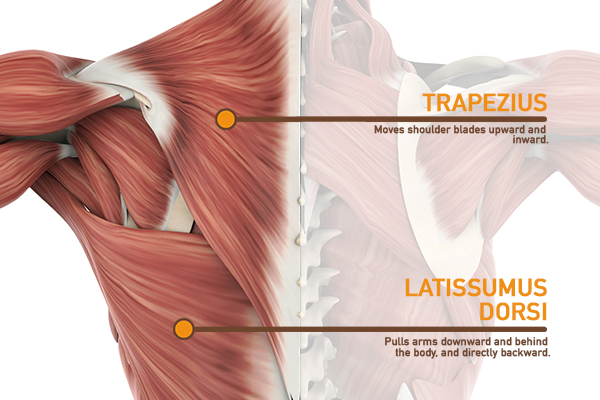How to Do a Renegade Row, Plus 2 Challenging Variations (Video)

A regular dumbbell row is all about back and bis. It strengthens the upper body’s largest muscle, the latissimus dorsi, while also hitting a range of muscles in the upper back and giving the biceps a nice burn. But the renegade row accomplishes all that, and then some. It also works as a core exercise.
“The renegade row is a two-in-one exercise, giving you the benefits of doing a dumbbell row and plank in a single move,” says Trevor Thieme, C.S.C.S.
Does it replace doing those two exercises separately? “Not completely,” Thieme says. “But it’s an excellent double-duty exercise to keep in your rotation.”
Here’s how to perform the renegade row properly, and why you should add it to your fitness routine.
How to Do the Renegade Row With Perfect Form
Appears in: SHIFT SHOP >> Strength :25
- Assume a push-up position with your hands just outside shoulder-width, gripping two dumbbells. Your feet should be in line with your hands, and your body should be straight from head to heels.
- Keeping your core braced and elbow tucked, bring the dumbbell in your right hand to your ribs. Resist rotating your body. The only parts of you that should be moving is your arm and shoulder.
- Lower the right dumbbell to the floor and repeat with the left one. Continue alternating sides.
How to Make the Renegade Row Easier
Use lighter weights, or perform the move with the weights on a stable, elevated surface (e.g., a bench, box, or low wall) so that you’re body is at an incline.
The steeper the incline, the easier the movement becomes.
How to Make the Renegade Row Harder
If elevating your hands makes the move easier, then the opposite of that will make it harder. For a greater challenge, try a decline renegade row by elevating your feet on a sturdy bench or box, Thieme says.
Or, when two exercises in one is still not enough, you can add more elements into the move to make it even more challenging.
Here are two of our favorite renegade row variations that build extra core stability and strengthen the chest even more.
Variations of the Renegade Row
Once you’ve mastered the basic renegade row, spice things up with these more demanding variations.
Renegade Row Push-Up

- Assume a push-up position with your hands just outside shoulder-width, gripping two dumbbells. Your feet should be in line with your hands, and your body should be straight from head to heels. This is the starting position.
- Keeping your core braced and elbows tucked, perform a push-up.
- When you return to the starting (straight arm) position, raise the dumbbell in your right hand to the right side of your body, being sure to keep your elbow tucked, not flared. Resist rotating your body. As with the standard renegade row, the only parts of your body that should move are your arms.
- Lower the dumbbell back to the starting position, and then row the left dumbbell to your left side.
- Return to the starting position, and continue to repeat the entire movement sequence (push-up, row, row) for the prescribed number of reps.
Renegade Row Cross Climber
- Assume a push-up position with your hands just outside shoulder-width, gripping two dumbbells. Your feet should be in line with your hands, and your body should be straight from head to heels. This is the starting position.
- Keeping your core braced and elbows tucked, perform a push-up.
- When you return to the starting (straight arm) position, raise the dumbbell in your right hand to the right side of your body, being sure to keep your elbow tucked, not flared. Resist rotating your body. As with the standard renegade row, the only parts of your body that should move are your arms.
- Lower the dumbbell back to the starting position, and then row the left dumbbell to your left side.
- Lower the dumbbell back to the starting position, and perform a cross climber: bring your right knee as close to your left elbow as you can, return to the starting position, and then repeat with your left knee and right elbow.
- Repeat the entire movement sequence for the prescribed number of reps.
Bonus Tips for Doing the Renegade Row
“The most common mistake people make with renegade rows is the same one they make with planks and push-ups: allowing the hips to sag,” Thieme says. “It’s critical that your body remains straight from head to heels, and the best ways to do that are to brace your core (as if someone is about to punch you in the gut) and to clench your glutes.”
Benefits of the Renegade Row
While the renegade row is a combination of a dumbbell row and plank, it’s also a combination bilateral and unilateral exercise.
This means that it trains both arms together (in the plank) and both arms separately (in the row).
“The unilateral element helps ensure muscular balance by not allowing one side of your body to do more work than the other,” Thieme says. Essentially, you’re getting the best of both kinds of training at the same time.
What Muscles are Used in a Renegade Row?
This all-star move hits multiple muscle groups at once, but the groups it activates the most are the biceps, traps, lats, and core.
Biceps

The biceps (specifically, the biceps brachii) is the most visible muscle on the front of your upper arm.
It has two heads – the short head and the long head – that are activated when you bend your arm at the elbow. The biceps is also responsible for rotating the forearm outward.
Trapezius
The trapezius muscles, a.k.a. “the traps,” are located in your upper back, and are primarily responsible for the movement of your scapulae (i.e., shoulder blades).
When they’re built, these muscles bulk up the area by your neck and shoulders. In sports, your traps help you throw, swing, and climb.
In the gym, they help you row (like in the renegade row), press, and pull. Any time you shrug or brace your shoulders to lift or carry a heavy object, you’re activating your traps.
Latissimus Dorsi

The latissimus dorsi, or “the lats,” are fan-shaped muscles on either side of your mid and lower back.
The lats are your primary “pulling” muscles. They’re responsible for bringing the arms toward your body and turning the front of your arms toward your chest.
When they’re developed, they give your torso the “V” shape when viewed from behind.
Core
Your core encompasses a lot more than just your abs.
It includes your entire midsection, front and back, including the rectus abdominis (or the “six-pack” muscle that runs down the center of your stomach), the traverse abdominis (i.e., the body’s internal “weight belt”) that wraps around your torso, the obliques, which run down the sides of your torso, and the erector spinae (located along your spine) among many others.
Together, all these muscles work to perform the very important task of stabilizing your spine.
